The History of Sydney HiH
The life and times of a beloved city icon.
In the wake of Sydney HiH’s demolition, it seems only warranted to lament defeat, to curse its adversaries, and to honor a loved one now lost. Though the bricks and mortar are gone, some scattered among the basements of those that fought to preserve her, the spirit of Sydney HiH lives on. Rarely has there been a building with such a prolific affect on such a diverse group of individuals. It is the many layers of history and significance attached to these buildings that engage a vast and varied audience. For this reason, the buildings’ demise was particularly stinging.
The complex now known as “Sydney HiH” was comprised of four buildings constructed independently over the course of three decades. These buildings represent nearly half a century of architectural history with the earliest constructed in 1860 and the latest in 1895. The buildings date to a time when Third and Juneau was the center of a village aptly named Kilbourntown for Milwaukee founder, Byron Kilbourn, who had established his trading post at this very intersection where we recently struggled to salvage an icon of culture and history. Later the village became known as the West Side, a thriving neighborhood largely populated by German Americans with Sydney HiH at the heart of the commercial district. Following Sydney HiH’s demolition, the two blocks of Old World Third Street contain the only grouping of buildings that remain of this once-bustling district.
Historically, the crowning building at 300 East Juneau is known as the Senn Block. Nicholas Senn, a native of Switzerland, began his medical practice as a country doctor in Fond du Lac County before working as a Milwaukee physician from 1874 to 1891. Senn conducted experiments in his basement laboratory, which according to the Wisconsin Historic Society, “led to [his] international renown as the great master of abdominal surgery.”
In 1891, after the surgeon’s relocation too Chicago, George Koch purchased the Senn Block to open a west side branch of the Merchants’ Exchange Bank. However, the Merchants’ Exchange was soon acquired by First National Bank. In 1894, a group of men sought control of the branch in order to establish an independent bank to serve the west side community. The West Side Bank opened for business on July 2, 1894 and remained at this location until 1967.
In 1971, Sydney Eisenberg purchased the group of buildings with the intentions of opening a center for artists and craft persons to create, demonstrate, exhibit and sell their wares. Though ripe for demolition in the wake of the Park East Freeway, Sydney Eisenberg envisioned a vertical arts and crafts complex that would provide an educational presentation of art, craft, music, dance and theater. Behind an exterior wall resembling a patchwork quilt, visitors meandered through four floors of nooks, crannies, and maze-like passageways while perusing the specialty crafts of a diverse array of artisans throughout the 1970s.
Sydney HiH may be one of few buildings that is lauded and revered for its cultural history as an artistic incubator in the 1970s and a haven of counter culture and music into the 1990s. The building had a profound effect on the maturation of generations of adolescents that found themselves, found community and lifelong friends, and discovered music that would become the soundtrack of their nostalgic recollections. Within these walls new identities were born, marriages were formed, and children were conceived. Punk rock lived; art covered the walls and doorways. Sydney HiH was a savior for some and a bad influence for others. It allowed people to be themselves without apology.
Sydney Hih was put up for sale in 2000 and the Park East Freeway came down in 2002, leaving the complex standing alone in a barren corridor. For the past decade, Sydney HiH stood vacant, the bright paint of the boarded windows beckoning to the curiosity of passersby, the neon emblems representing a period of history unbeknownst to many. Although an immense community outcry vied for the buildings reuse, demolition ensued on August 9th, 2012.
Sydney HiH influenced generations of young, creative individuals that continue to contribute to the City of Milwaukee. Within the last six months that unabashed passion for counter culture, for art, for music and for community has resurfaced in everyone that experienced it first hand and subsequently projected it onto those of us that were unable to be there. Though in the end, a bitter battle with the Department of City Development resulted in its demolition, the concept behind Sydney HiH and the environment it fostered continues on in the endeavors and pursuits of those who were a part of its history.
Photo Gallery: Last Days of the Sydney HiH
Sydney HiH Retrospective at Urban Milwaukee
The Sydney HiH complex may have been demolished, but it’s far from gone. This Friday Oct 19th, 2012 evening Urban Milwaukee: The Store will throw a send off party to the center of Milwaukee’s counter-culture movement. Running from 5 p.m. until midnight as part of Gallery Night & Day, the exhibit will include everything from physical artifacts from the buildings to videos of bands playing at the Unicorn nightclub (Smashing Pumpkins, NOFX and others).
Urban Milwaukee: The Store
755 N. Milwaukee St (Colby-Abbot Building)
Friday: 5 p.m. until midnight
Saturday: 11 a.m. until 5 p.m.
Megan E. Daniels is an author specializing in historic architecture and preservation. Her first book, Milwaukee’s Early Architecture was published by Arcadia in 2010, and she writes RazedInMilwaukee, a blog covering preservation issues in Milwaukee.

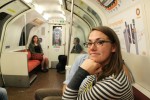
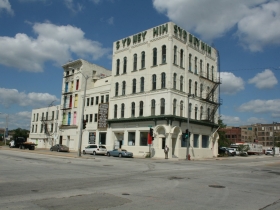
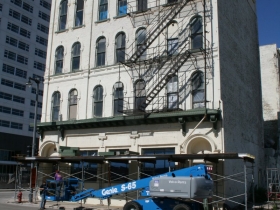
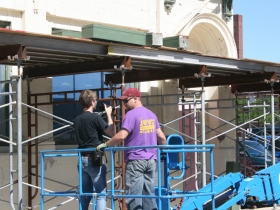
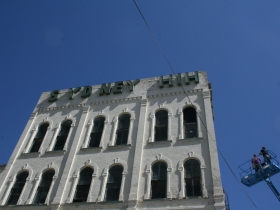
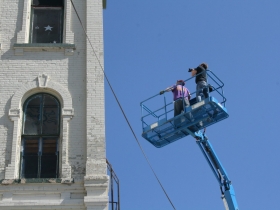
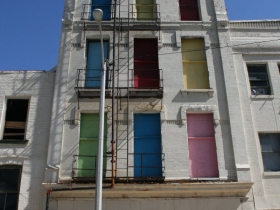
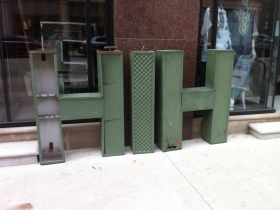




















Beloved? Those broken-down buildings — with only minor historical or architectural significance — were eyesores for years. If the full block had survived, you could make an argument for a historic district. As it was, the buildings sat totally out of context with the surrounding area. Good riddance.
Maybe not to you, Jeff, but these buildings were beloved by many. It’s hard to argue context in an area devoid of any recent meaningful definition. The Sydney Hih sat next to a freeway wasteland and eventual barren wasteland for years. Eventually a cheaply-built/designed hotel went up to the East while an elegant tower rose to the South. Part of the intrigue was the staying power alone.
The Sydney HiH sat quite comfortably within the historic nature of 3rd street. It just happened to be in isolation on all other sides. It could have served as a bridge to more thoughtful development in the Park East had it been adaptively reused like many of Milwaukee’s best streets. But that’s the past. Now we get another vacant lot that will likely house a hotel development every bit as lifeless as the ALoft.
Looking forward to seeing the gallery exhibit tonight.
Thank you for the interesting article on the history of the building. I’m curious what HiH stands for, if anything.
@ Sharon –
“Hih” is yiddish for “in honor of”.
The complex will always be fondly remembered by me…taking the Park East towards my home near Murray and Greenwich, the building stood as a welcome back to the East Side from the suburb I worked in. A place where a young man could sample arts, food, drink, and culture within a diverse yet overwhelmingly accepting part of town. Not to mention seeing Smashing Pumpkins and other great bands in the most raw and personal way imaginable, then heading upstairs to jam and socialize in a setting that will probably never be recreated again here. It is a shame that neglect and outside pressures led to the demise of this gem that could have served so many other purposes, perhaps part museum of Senn and other Milwaukee science pioneers’ achievements, part Milwaukee music and culture history display, or even accessible recording space for local musicians looking for a break into the business. But, like the Norman, most relegate these spots to bygone eras and accept their passing. Hopefully social media will not entirely replace the social interaction that brought so much to so many under this and other roofs.
My husband and I and two friends were reminiscing here in Florida about the good times we had in the “70’s. Sidney HIH came up and we googled it to find that it no longer exists in substance, but now only in our memories. We had great times partying in that neighborhood and will never forget that part of Milwaukee’s history. Now at 75, I can no longer party, but enjoy the remembrances.